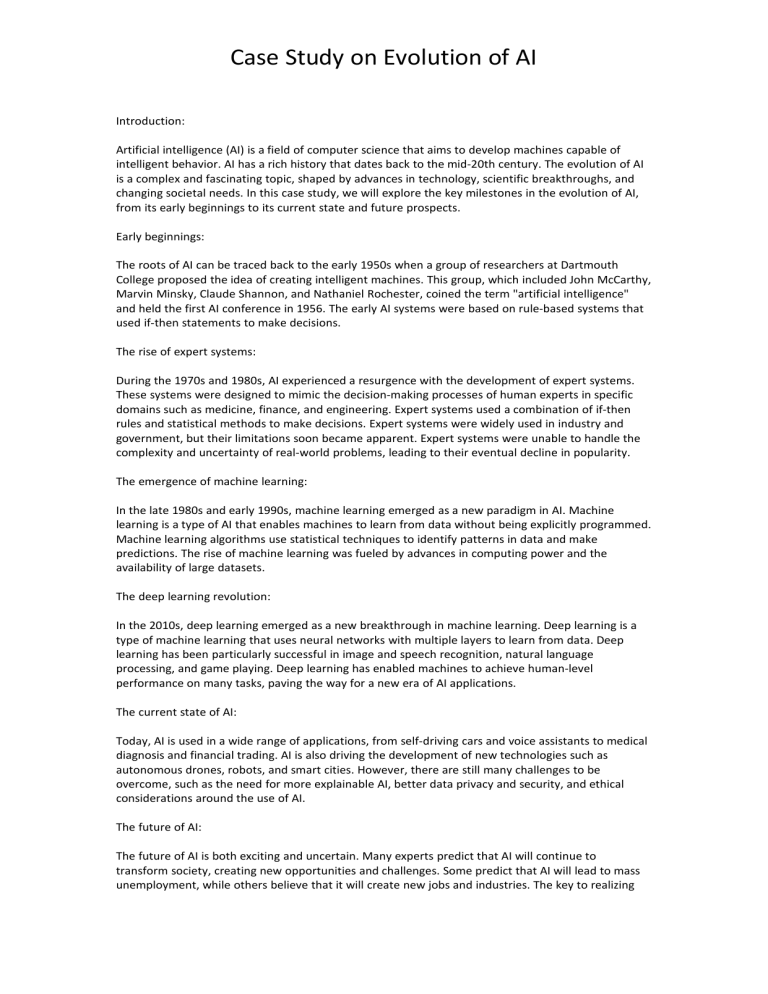
Case Study on Evolution of AI Introduction: Artificial intelligence (AI) is a field of computer science that aims to develop machines capable of intelligent behavior. AI has a rich history that dates back to the mid-20th century. The evolution of AI is a complex and fascinating topic, shaped by advances in technology, scientific breakthroughs, and changing societal needs. In this case study, we will explore the key milestones in the evolution of AI, from its early beginnings to its current state and future prospects. Early beginnings: The roots of AI can be traced back to the early 1950s when a group of researchers at Dartmouth College proposed the idea of creating intelligent machines. This group, which included John McCarthy, Marvin Minsky, Claude Shannon, and Nathaniel Rochester, coined the term "artificial intelligence" and held the first AI conference in 1956. The early AI systems were based on rule-based systems that used if-then statements to make decisions. The rise of expert systems: During the 1970s and 1980s, AI experienced a resurgence with the development of expert systems. These systems were designed to mimic the decision-making processes of human experts in specific domains such as medicine, finance, and engineering. Expert systems used a combination of if-then rules and statistical methods to make decisions. Expert systems were widely used in industry and government, but their limitations soon became apparent. Expert systems were unable to handle the complexity and uncertainty of real-world problems, leading to their eventual decline in popularity. The emergence of machine learning: In the late 1980s and early 1990s, machine learning emerged as a new paradigm in AI. Machine learning is a type of AI that enables machines to learn from data without being explicitly programmed. Machine learning algorithms use statistical techniques to identify patterns in data and make predictions. The rise of machine learning was fueled by advances in computing power and the availability of large datasets. The deep learning revolution: In the 2010s, deep learning emerged as a new breakthrough in machine learning. Deep learning is a type of machine learning that uses neural networks with multiple layers to learn from data. Deep learning has been particularly successful in image and speech recognition, natural language processing, and game playing. Deep learning has enabled machines to achieve human-level performance on many tasks, paving the way for a new era of AI applications. The current state of AI: Today, AI is used in a wide range of applications, from self-driving cars and voice assistants to medical diagnosis and financial trading. AI is also driving the development of new technologies such as autonomous drones, robots, and smart cities. However, there are still many challenges to be overcome, such as the need for more explainable AI, better data privacy and security, and ethical considerations around the use of AI. The future of AI: The future of AI is both exciting and uncertain. Many experts predict that AI will continue to transform society, creating new opportunities and challenges. Some predict that AI will lead to mass unemployment, while others believe that it will create new jobs and industries. The key to realizing Case Study on Evolution of AI the potential of AI will be to balance the benefits with the risks and to ensure that AI is used ethically and responsibly. Conclusion: The evolution of AI is a fascinating journey that has been shaped by technological breakthroughs, scientific discoveries, and changing societal needs. AI has come a long way since its early beginnings, from rule-based systems to deep learning. Today, AI is transforming many aspects of our lives, from healthcare to transportation. However, there are still many challenges to be overcome, and the future of AI is uncertain. It will be up to us to steer AI in the right direction, ensuring that it benefits society as a whole.

